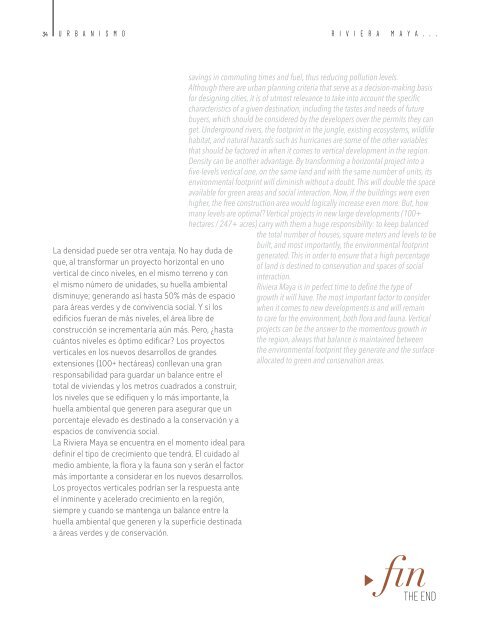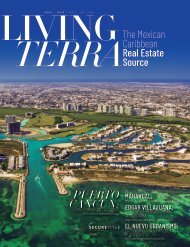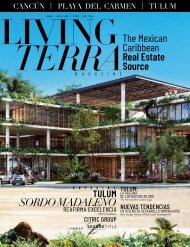You also want an ePaper? Increase the reach of your titles
YUMPU automatically turns print PDFs into web optimized ePapers that Google loves.
34<br />
U R B A N I S M O<br />
R I V I E R A M A Y A . . .<br />
35<br />
La densidad puede ser otra ventaja. No hay duda de<br />
que, al transformar un proyecto horizontal en uno<br />
vertical de cinco niveles, en el mismo terreno y con<br />
el mismo número de unidades, su huella ambiental<br />
disminuye; generando así hasta 50% más de espacio<br />
para áreas verdes y de convivencia social. Y si los<br />
edificios fueran de más niveles, el área libre de<br />
construcción se incrementaría aún más. Pero, ¿hasta<br />
cuántos niveles es óptimo edificar? Los proyectos<br />
verticales en los nuevos desarrollos de grandes<br />
extensiones (100+ hectáreas) conllevan una gran<br />
responsabilidad para guardar un balance entre el<br />
total de viviendas y los metros cuadrados a construir,<br />
los niveles que se edifiquen y lo más importante, la<br />
huella ambiental que generen para asegurar que un<br />
porcentaje elevado es destinado a la conservación y a<br />
espacios de convivencia social.<br />
La Riviera Maya se encuentra en el momento ideal para<br />
definir el tipo de crecimiento que tendrá. El cuidado al<br />
medio ambiente, la flora y la fauna son y serán el factor<br />
más importante a considerar en los nuevos desarrollos.<br />
Los proyectos verticales podrían ser la respuesta ante<br />
el inminente y acelerado crecimiento en la región,<br />
siempre y cuando se mantenga un balance entre la<br />
huella ambiental que generen y la superficie destinada<br />
a áreas verdes y de conservación.<br />
savings in commuting times and fuel, thus reducing pollution levels.<br />
Although there are urban planning criteria that serve as a decision-making basis<br />
for designing cities, it is of utmost relevance to take into account the specific<br />
characteristics of a given destination, including the tastes and needs of future<br />
buyers, which should be considered by the developers over the permits they can<br />
get. Underground rivers, the footprint in the jungle, existing ecosystems, wildlife<br />
habitat, and natural hazards such as hurricanes are some of the other variables<br />
that should be factored in when it comes to vertical development in the region.<br />
Density can be another advantage. By transforming a horizontal project into a<br />
five-levels vertical one, on the same land and with the same number of units, its<br />
environmental footprint will diminish without a doubt. This will double the space<br />
available for green areas and social interaction. Now, if the buildings were even<br />
higher, the free construction area would logically increase even more. But, how<br />
many levels are optimal? Vertical projects in new large developments (100+<br />
hectares / 247+ acres) carry with them a huge responsibility: to keep balanced<br />
the total number of houses, square meters and levels to be<br />
built, and most importantly, the environmental footprint<br />
generated. This in order to ensure that a high percentage<br />
of land is destined to conservation and spaces of social<br />
interaction.<br />
Riviera Maya is in perfect time to define the type of<br />
growth it will have. The most important factor to consider<br />
when it comes to new developments is and will remain<br />
to care for the environment, both flora and fauna. Vertical<br />
projects can be the answer to the momentous growth in<br />
the region, always that balance is maintained between<br />
the environmental footprint they generate and the surface<br />
allocated to green and conservation areas.<br />
finTHE END




